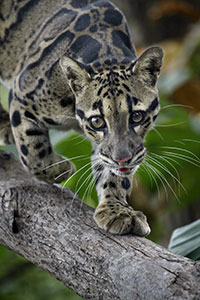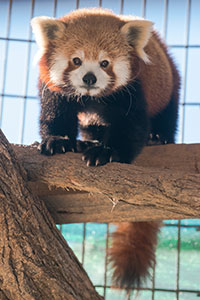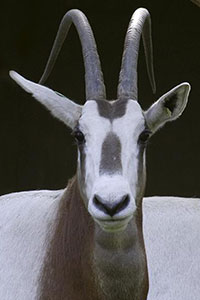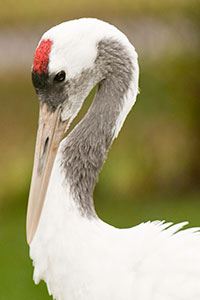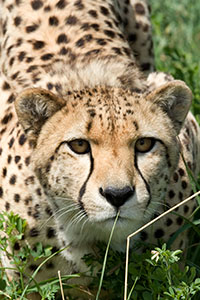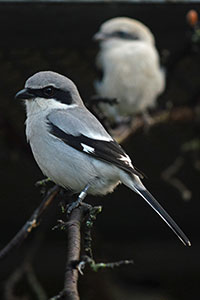Help Save Species While You Study
Everyone talks about making a difference in the world. Here's your chance to do it now.
The Smithsonian-Mason School of Conservation (SMSC), where students are taught and mentored by Smithsonian scientists, is the only program of its kind in the nation.
For one or more semesters, you can join the fight to safeguard vanishing species and preserve our planet's biodiversity through Mason's partnership with the Smithsonian Conservation Biology Institute (SCBI).
And you'll live where you learn, at the 3,200-acre institute in Front Royal, Virginia, among researchers and labs on the leading edge of conservation science. When our programs don't put you in the field, you'll conduct research in the:
- Genetics lab.
- Reproduction lab.
- Wet lab.
- Computer lab.
There are also two indoor classrooms and an outdoor classroom, where you might hear from guest speakers like Jane Goodall.

Conservationist and primatologist Jane Goodall tells Smithsonian-Mason School of Conservation students about her study of chimpanzees. She visited the school as part of her work with the Jane Goodall Institute.
Colleagues from U.S. and international conservation organizations, as well as resources from the Smithsonian Tropical Research Institute, the Smithsonian Environmental Research Center, and the National Museum of Natural History, will make you a part of a global community.
The Importance of Biodiversity
In addition to helping preserve highly endangered species, you'll work on broadening the gene pool of plants and animals to help protect biodiversity.
The Smithsonian Conservation Biology Institute, which houses Smithsonian Mason, is part of a global initiative to save species from extinction and to train and educate conservationists.
Species with good genetic diversity are more resistant to disease and more adaptable to a changing environment. All organic life, from one-celled organisms, to plants, to animals are part of an ecosystem. Their roles affect:
- Water's cleanliness and purity.
- Soil's ability to support plant life.
- Pest population control.
- Weather conditions.
- Plants' ability to pull toxins from the atmosphere.
If any part of the ecosystem is missing, it won't operate correctly, which could cause serious problems up and down the food chain.
SCBI is working with 23 species, including:
Clouded Leopard
Neofelis nebulosa
Clouded leopards' habitat includes Nepal, Bangladesh, India, Indochina, Sumatra, Borneo, and China. They are one of two cat species that can climb down trees head first. Unlike other cats, they can neither roar nor purr.
The cats are carnivores that prey on gibbons, macaques, deer, boars, birds, and rodents. They are considered vulnerable due to:
- Poaching for skins, bones, and meat.
- Loss of habitat.
- Deforestation.
- Human encroachment.
Przewalski's Horse
Equus ferus przewalskii
Przewalski's horses, extinct in the wild and considered critically endangered, were last found in the Gobi Desert in Mongolia. The name comes from Russian explorer Nikolai Przewalski, who first described them scientifically in the 1870s.
The horses grazed on grass and leaves from shrubby trees. In addition to SCBI, scientists are working to re-introduce them in Mongolia, China, and Kazakhstan. They are extinct in the wild due to:
- Human encroachment.
- Changes in the environment.
- Hunting.
- Loss of habitat.
Red Panda
Ailurus fulgens
Red pandas are not close relatives of giant pandas, although both are native to Asia; red pandas are found in Myanmar (Burma) and China.
Their primary diet is bamboo leaf tips and shoots, but they also forage for roots, succulent grasses, fruits, insects and grubs. They have been known to kill and eat birds and small mammals. The species is considered endangered due to:
- Loss of habitat.
- Deforestation.
- In-breeding due to declining population.
- Poaching for their fur.
Scimitar-Horned Oryx
Oryx dammah
This oryx, which is extinct in the wild, once lived in the Sahara and Sahel regions of Northern Africa, including Morocco, Tunisia, Algeria, Libya, Egypt, Mauritania, Mali, Niger, Chad and Sudan.
The animals are adapted to desert life, getting moisture from grasses, herbs, roots, buds, wild melon, twigs, and shoots. Scientists are working on re-introduction plans after non-captive populations went extinct due to:
- Human encroachment.
- Over-hunting.
- Drought.
- Loss of food due to excessive livestock grazing.
Red-Crowned Crane
Grus japonensis
The red-crowned crane of Russia, China, Mongolia, and Japan, is one of the world's largest cranes, at about 5 feet tall. It nests in deep-water marshes with standing vegetation. Some populations are migratory.
Its diet includes fish, amphibians, rodents, reeds, grasses, heath berries, corn, and rice. The species is considered endangered due to:
- Loss of habitat.
- Deforestation.
- Human encroachment.
- Pesticide poisoning.
Maned Wolf
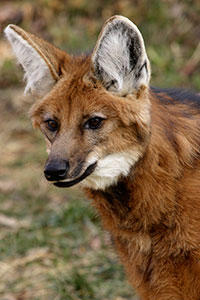
Chrysocyon brachyurus
The maned wolf of South America looks like a long-legged fox, but is a distinct species. Its habitat includes parts of Argentina, Brazil, Paraguay, Bolivia, and Peru. Instead of howling, they make loud barks or roars.
Maned wolves are omnivorous — they eat fruits, vegetables, small animals, birds, and insects. The species is considered near-threatened due to:
- Loss of habitat.
- Susceptibility to disease.
- Poaching for their organs.
- Human encroachment.
Cheetah
Acinonyx jubatus
Cheetahs, which have become extinct in at least 13 countries, are most prevalent in Kenya, Tanzania, Namibia, and Botswana. The Asiatic cheetah in Iran is critically endangered.
They are carnivorous and eat a variety of animals such as small antelope (springbok, steenbok, duikers, impala, gazelles), warthogs, oryx, roan, sable, game birds, and rabbits. They are considered vulnerable due to:
- Loss of habitat.
- Human encroachment.
- Limited genetic diversity.
- Susceptibility to disease.
Loggerhead Shrike
Lanius ludovicianus
The loggerhead shrike, which can be found throughout North America, is sometimes called the butcher bird or thorn bird because it will impale prey on sharp objects, such as thorns.
It has a varied diet that includes invertebrates, grasshoppers, beetles, rodents, frogs, turtles, small reptiles, ground squirrels, voles, mice, shrews, and small songbirds. Populations have fallen in the last century, and the birds are considered at risk due to:
- Pesticide poisoning.
- Loss of habitat.
- Human encroachment.
- Loss of prey.

